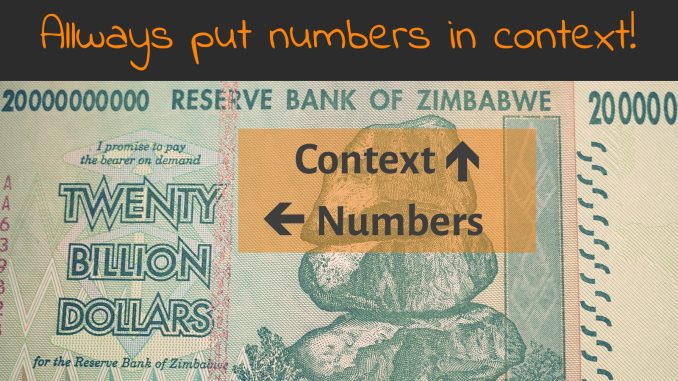
Here’s an important lesson for life: always put numbers in context. E.g., the fact that I own 20 billion dollars. Unfortunately, it’s Zimbabwean dollar, which is worthless. (*) And with that in mind: what’s up with the first Landa Nano S10P achieving 20 million flats? Is that a huge achievement as the number – twenty million! – suggests? Let’s do some calculations and find out.
CONTENTS: The New Achievement | The monthly volume | The other thing… | The 13.000 sheets/hour video | Why is this important?
As you probably have noticed, I pay special attention to Landa Digital Printing. Some people ask why. Because in 2012, that’s over a decade ago, we were promised a revolution: “Printing will never be the same!” Many printers threw away the investment plans they had when preparing for drupa 2012, or at least put them on hold to find out more about this new technology. Over 400 even signed a letter of intent, including a down payment. Today, the number of Landa Nano presses in the field is still limited (at the day of publication, I have 30 sales and installments in my list). But Landa Nano takes up so much space in social and trade media, with messages about successful events, celebrations, and a huge crowd of fanboys, that a reality check is needed. If you don’t pay attention, you might think Landa Nano is the biggest success ever. (**) That’s why we need context. E.g., for this new celebration: 20 million flats on one of the Landa Nano S10P presses.

The machine that achieved that mark is installed at Em. de Jong in The Netherlands, number 16 on my list (please keep that number in mind, it’s relevant). According to the local trade press, it was installed in April 2021. Let’s assume that it became operational (productive) starting June 2021. This seems a reasonable assumption to me. It’s not a beta press, it’s supposed to be a production press. So, starting June 2021, that’s 28 months until the end of October 2023. And that number makes it possible to put the 20 million in context:
- 20 million flats in 28 months:
- 714.285 flats/month
- 39.682 flats/day (at 18 working days on average per month)
- 4.954 flats/hour if in 1 shift (8 hours)
- 2.480 flats/hour if in 2 shifts (16 hours)
- 1.653 flats/hour if in 3 shifts (24 hours)
After I had made the calculation above, I received new information: late December 2022, they had hit the 10 million mark.
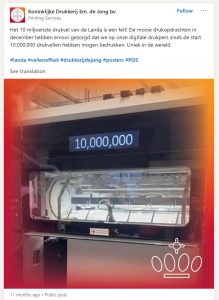
So, let’s do that calculation again, but with 10 million between the end of December and end of October 2023. Which is 10 months.
- 10 million flats in 10 months:
- 1 million flats/month
- 55.556 flats/day (at 18 working days on average per month)
- 6.944 flats/hour if in 1 shift (8 hours)
- 3.472 flats/hour if in 2 shifts (16 hours)
- 2.315 flats/hour if in 3 shifts (24 hours)
Based on that second calculation, it must run in 2 shifts, at least, otherwise they would print at a higher speed than advertised. Which is 6.500 sheets/hour. Although at one time, there was a claim it could go up to 13.000 sheets/hour (more on that later). However in 2 shifts, at 3.472 flats/hour, that seems a bit low to me…
But, as Elizabeth Gooding from InkjetInsight.com pointed out in a comment on LinkedIn, ‘mileage may vary’. She is correct, it indeed depends on several factors. There is necessary maintenance, but also switching substrates takes time. And some substrates can’t be printed at the maximum speed.
Although I don’t know how much shifts it runs at this moment, I do know what they intended… After my initial LinkedIn post last week, someone send me a screenshot of this job post. Which states: 3 shifts (“3 ploegen” in Dutch).
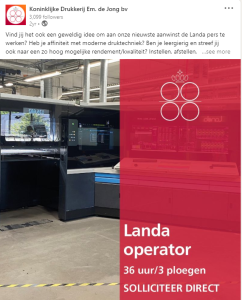
If they really run that press in 3 shifts, 2.315 flats/hour on average, that seems on the low side, compared to the advertised speed. Even if it is running in 2 shifts, at 3.472 flats/hour, that’s still seems on the low side. So here’s important advice, dear printer: if you want to invest in a press, you need to check this: what’s the print speed in real life, and what is the average downtime? This accounts for EVERY press, digital or conventional. Do check this when looking around for new equipment! If possible, check this with someone who has such a press installed!
I also received something else… a picture of what seems to be a Landa press console. What’s interesting is that it does not only show the ‘Succesful printed sheets’, it also shows ‘Non printed sheets’. Anybody an idea what that could be about, non printed sheets that are registered by the press? It might be something significant: it was over 10% of total amount of sheets. Since I don’t want to get the person who probably shared this somewhere without thinking about it in troubles, I’m not going to share it here. But it seems genuine.
The monthly volume
An other important specification to look at when investing in a digital press is the monthly volume, the duty cycle. Now, I have to admit that this can be challenging… And you need to make sure you aren’t comparing apples with oranges. Sometimes this volume is in sheets, sometimes in ‘prints’ or ‘flats’. When printing only on one side, that will be the same, but when you are printing on both sides, one sheet is two prints. So do check this properly!
To put the 714.285 and 1 million flats/month that I calculated above in context, let’s look at some other digital presses.
The number of B1 digital presses is minimal. There is the Koenig & Bauer Durst VariJET 106, which targets a monthly volume of up to 2 million sheets. Please note that this press is geared towards folding cartons. The latest information I found is from early May 2023, which states that the first beta started that month, the second a few weeks later. The first commercial customer would go live in the second half of 2023. For the record, beta sites were already promised in 2020…
There have been several other announcements of B1 digital presses in the past, but most didn’t materialize into a production model currently for sale. So, let’s also look at a few B2 presses, to have a bit more context.
HP Indigo 100K: over 2 million B2 sheets/month (with 100 installations in March 2022)
Ricoh Pro Z75: 1,7 million B2 impressions/month according to their product information, but some articles (like this one) mention 2,6 million B2 impressions/month (first installment: November 2022 )
There are more B2 digital presses, but I have to admit this intended monthly volume is often not mentioned in the specifications. However, this is an essential one when you want to invest… So, dear vendors, please share this number.
When going a bit smaller in size, things can get complicated…
Xerox iGen5: recommended average monthly volume: up to 500.000 pages/month
Xerox Iridesse: recommended average monthly volume: 225.000 – 475.000 impressions/month; duty cycle: up to 2.250.000 impressions/month. Interesting that Xerox for this press makes a difference between ‘recommended volume’ and ‘duty cycle’, while not making that difference for the iGen5. Why? Update: someone left a link in a comment which does show the iGen5 duty cycle, depending on the type, it can be up to 4,5 million/month.
Canon varioPRINT iX3200: duty cycle: 1.000.000 – 10.000.000 A4 impressions/month. Please note that this number is in A4 impressions, not in sheets or ‘full-size impressions’. And that’s why you always have to put numbers in the proper context. And as with others, when printing on both sides: 1 sheet = 2 impressions.
The other thing…
Next to the average speed in real-life conditions, there is something else I’m curious about: why is Em. de Jong the first to reach the 20 million flats? Remember, there were 15 installations before this one!
And one of the earlier installations was at Simian, the first Landa printer to pass the 1 million flats/month. And that achievement dates from March 2022. So, from that month until October 2023, that’s 20 months. In March 2022, they produced 1,3 million flats on that press. So, if they had kept the same production amount, they should have reached the mark of 20 million flats before Em. de Jong…
Ok, I know, it’s a bit simplistic, that calculation: the Summer months are probably lower in orders, and there could be other seasonal differences. But be aware: I didn’t start counting from the installation date… that was Summer 2020. I received a print sample from Simian at the end of September or early October 2020. This press has been running for over 3 years, over 36 months… And Simian has claimed in the past that they were shifting jobs from their Komori offset presses to the Landa S10P, so shouldn’t they have been able to keep that 1+ million flats/month? Reaching the 20 million flats earlier than Em. de Jong?
And here is the deal: either the story about Em. de Jong being the first to reach 20 million is not correct. Or the other 15 that had an earlier installment don’t reach the same productivity. Are the others having technical issues to go beyond that number? Or aren’t they as successful in selling print that fits the Landa press? This would be weird since this press was touted as a solution for almost every print job…
What do you think? Did I make a mistake in my train of thought? Any other thoughts? Please leave a comment!
And to put it all into context, let’s look at some of the 15 earlier installments and do a little calculation.
The first installment was at Graphica Bezalel, in August 2017. This was a beta site, so let’s suppose it became productive 6 months later, in January 2018. To be below the 20 million flats by the end of October 2023, the average monthly volume should be below 259.740 flats, which equals to a productivity of 1.804 flats/hour if running in 1 shift, 902 flats/hour if running in 2 shifts.
Or let’s check the S10P at Groupe Prenant, which arrived in November 2019 and started being productive in January 2020 according to this article. That’s a monthly volume of 425.532 flats to stay below the 20 million. Which means 2.955 flats/hour in a 1 shift operation, or 1.478 flats/hour in a 2 shift operation. The article, which dates from March 2021, claimed it worked in 1 shift of 8 hours/day. And that they were investigating a second Landa press.
What do you think? Did I miss anything?
The 13.000 sheets/hour video
I already mentioned that video showing a Landa press running at 13.000 sheets/hour. There is a YouTube video, which I linked to in previous articles and probably also on LinkedIn. Guess what: that video has now been made private! You can’t see it anymore on YouTube… Why?
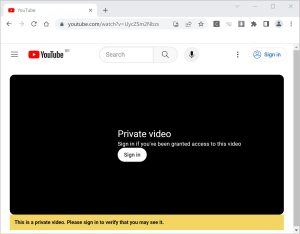
After mentioning on LinkedIn that the video is now hidden, one of my contacts notified me that the video is still available on Facebook… At least at the moment of writing. So, if it would also disappear there, here is a screenshot.
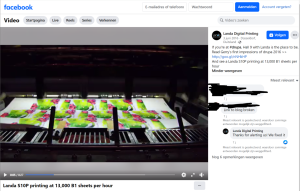
Please note the date: this was during drupa 2016. And Landa invited people to visit the booth to see it running at 13.000 sheets/hour. I was there, I did see it running (from far away, not being a VIP, I could not see the press from close by). But only at a relatively low speed. Now, I was only for a short time at the Landa booth (there was a lot of other interesting stuff to see at drupa 2016), so I might have missed the 13.000 sheets/hour demo. In case you did see it, feel free to leave a comment!
Why is this important?
Printing companies’ profitability and survival depend on their equipment. Investments should be carefully studied, all information should be considered and put into context. Comparisons should not only be old versus new (new will probably always win), but also different new options. Comparisons should also be based on real-life experiences: who has bought something similar? What is their experience with it?
Investment decisions should NEVER be based on ‘hurrah messages’ in social and print media. No matter from which vendor these come.
Please, dear printer: always do your homework! It might be the most boring offering that might fit your business best, not the shiny one that everyone is talking about…
(*) at this moment, the Zimbabwean dollar is not the official currency anymore. Hyperinflation was responsible for huge numbers on currency notes, like my 20 billion dollars. Which wasn’t the highest number, the Wikipedia page shows a picture of a 100 trillion dollar note…
(**) to compare the success of Landa Digital Printing with another new entry in digital printing presses, let’s look at the Océ / Canon VarioPrint series. This is one I know a bit closer. In the early days of what was then called the Niagara project, I was involved with the training of that team. The first time they showed the Niagara project publically, if I recall correctly, was Print 13, so one year after the announcement of Landa Nano. The press eventually was introduced in 2015, I’m not sure about the first installation. But now, they already have the third iteration of that series. Worldwide are over 600 presses installed… Yes, I know, it’s a different format and market, but it does show the difference in market approach. Canon doesn’t send out hurray messages regularly, but it does deliver digital presses to its customers. As does HP Indigo with its 100K B2 press.
UPDATE 20/10/2023: in one of the newsletters I receive, I noticed an article about a record number of sheets printed on a manroland ROLAND 700. This is of course an offset press, so directly comparing the numbers of that press to a Landa press is comparing apples and oranges. But it does add some context. Here’s the article stating that one of the ROLAND 700 presses of a Chinese printing company has passed the 1 billion mark! They seem to have 5 ROLAND 700 presses, all producing over 6 million impressions per month… All presses were installed between 2014 and 2016.
UPDATE 08/06/2024: I took home over a dozen samples from Landa Nano from drupa 2024. Here’s my review (and it doesn’t look that good): Landa Nano, The Good, The Bad, The Ugly.





Interesting Eddy. Why only 18 productive days a month, I have always worked on 21 days a month with these type of calculations . Are you allowing for a lot of maintenance downtime?
Hi Paul, how I got to 18 days a month: in Belgium we usually take 220 productive days per year, divided by 12, that’s 18. Those 220 days takes into account public holidays, vacation, …
You could of course recalculate everything to 21 days a month. But this would not improve the productivity per day or per hour of course. 😉
Thanks Eddy. For an investment of this size, guessing around 1.5m euros , to get a ROI together with a competitive hourly rate would need to produce using a 2-3 shift pattern.
One would surmise that over a 8 hour shift, this zero make ready press would be producing printed sheets for at least 6.5 hours @6,500 sheets an hour.
So 42,250 B1 sheets per shift. The figures you have indicate that the press quoted is producing at around 60% of that volume. Difficult to understand
Paul, you’re being a bit too optimistic on the investment level… The prices I’ve heard are significantly higher. The only public reference I can find, is this article in a magazine, that says the following: “Essentra Packaging has announced a multi-million pound investment in a new Landa S10 nanographic printing press for cartons (…)” And that’s the S10 version, not the duplex S10P.
Very insightful article. Thank you for digging into this.
iGen duty cycle – https://www.support.xerox.com/en-us/article/en/x_dcigen3f_en-O17090